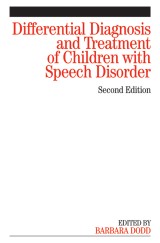Details

Differential Diagnosis and Treatment of Children with Speech Disorder
2. Aufl.
|
53,99 € |
|
| Verlag: | Wiley |
| Format: | |
| Veröffentl.: | 30.05.2013 |
| ISBN/EAN: | 9781118713341 |
| Sprache: | englisch |
| Anzahl Seiten: | 368 |
DRM-geschütztes eBook, Sie benötigen z.B. Adobe Digital Editions und eine Adobe ID zum Lesen.
Beschreibungen
Paediatric speech and language therapists are challenged by diminished resources and increasingly complex caseloads. The new edition addresses their concerns. Norms for speech development are given, differentiating between the emergence of the ability to produce speech sounds (articulation) and typical developmental error patterns (phonology). The incidence of speech disorders is described for one UK service providing crucial information for service management. <p> The efficacy of service provision is evaluated to show that differential diagnosis and treatment is effective for children with disordered speech. Exploration of that data provides implications for prioritising case loads. The relationship between speech and language disorders is examined in the context of clinical decisions about what to target in therapy.</p> <p> New chapters provide detailed intervention programmes for subgroups of speech disorder: delayed development, use of atypical error patterns, inconsistent errors and development verbal dyspraxia. </p> <p> The final section of the book deals with special populations: children with cognitive impairment, hearing and auditory processing difficulties. The needs of clinicians working with bilingual populations are discussed and ways of intervention described. The final chapter examines the relationship between spoken and written disorders of phonology.</p>
Preface. <p>General Preface.</p> <p>Contributors.</p> <p>Acknowledgements.</p> <p>PART I: UNDERSTANDING SPEECH-DISORDERED CHILDREN.</p> <p>Chapter 1. Children with speech disorder: defining the problem.</p> <p>Chapter 2. Children's quisition of phonology.</p> <p>Chapter 3. Differential diagnosis of phonological disorders.</p> <p>Chapter 4. Childhood apraxia of speech.</p> <p>Chapter 5. Epidemiology of speech disorders.</p> <p>Chapter 6. The relationship between specch disorder and language.</p> <p>PART II: TREATMENT OF PHONOLOGICAL DISORDER.</p> <p>Chapter 7. A problem-solving approach to clinical management.</p> <p>Chapter 8. A procedure for classification of speech disoder.</p> <p>Chapter 9. Phonological approaches to intervention.</p> <p>Chapter 10. Treating inconsistent speech disorders.</p> <p>Chapter 11. Childhood apraxia of speech: treatment case studies.</p> <p>Chapter 12. Clinical differences.</p> <p>PART III: SPEECH DISORDERS IN SPECIAL POPULATIONS.</p> <p>Chapter 13. Phonological abilities of children with cognitive impairment.</p> <p>Chapter 14. Hearing impairment.</p> <p>Chapter 15. The relationship between auditory processing and phonological impairment.</p> <p>Chapter 16. Bilingual children with phonological disorders: identification and intervention.</p> <p>Chapter 17. Understanding the relationship between speech and language impairment and literacy difficulties: the central role of phonology.</p> <p>Appendices.</p> <p>References.</p> <p>Index.</p>
Barbara Dodd, University of Queensland, Australia
Paediatric speech and language therapists are challenged by diminished resources and increasingly complex caseloads. The new edition addresses their concerns. Norms for speech development are given, differentiating between the emergence of the ability to produce speech sounds (articulation) and typical developmental error patterns (phonology). <p> The incidence of speech disorders is described for one UK service providing crucial information for service management. The efficacy of service provision is evaluated to show that differential diagnosis and treatment is effective for children with disordered speech. Exploration of that data provides implications for prioritising case loads. The relationship between speech and language disorders is examined in the context of clinical decisions about what to target in therapy.</p> <p> New chapters provide detailed intervention programmes for subgroups of speech disorder: delayed development, use of atypical error patterns, inconsistent errors and development verbal dyspraxia. </p> <p>The final section of the book deals with special populations: children with cognitive impairment, hearing and auditory processing difficulties. The needs of clinicians working with bilingual populations are discussed and ways of intervention described. The final chapter examines the relationship between spoken and written disorders of phonology.</p>

















